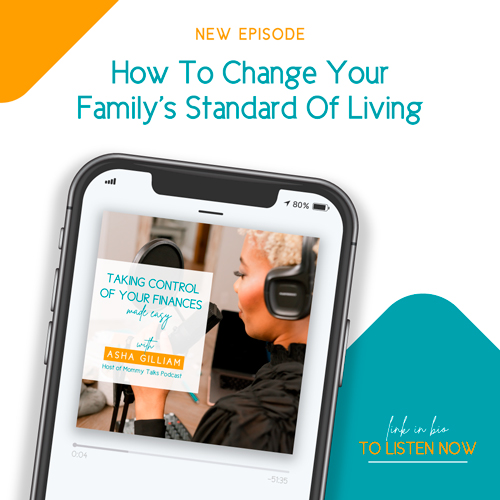MOMMY TALKS PODCAST Episode 12
- MOMMY TALKS PODCAST
Debt is a serious obstacle facing 87% of American families who are attempting to attain financial success. Many of those families don’t realize just how significant having a family budget in place can work for them and their family’s success.
The majority of U.S. households have the same major categories of expenses which include providing a roof over you and your family’s heads, food in your belly, clothes on your body and a way to get to and from work or school. But depending on your circumstances or your stage in life, you might also be spending a ton more on childcare, on college tuition, or on healthcare.

Let’s Take A Look At How Much We’re Spending On What Exactly

About 64% of U.S. households own their home, and more than half of those homeowners have a mortgage. Homeowners pay an average of $9,552 per year (nearly $800 per month) on mortgage interest, property taxes, and other expenses such as maintenance, repairs, and homeowners’ insurance. The average mortgage payment also includes an additional amount each month that goes towards the principal, effectively turning cash earnings into home equity.
The 35% of Americans who rent pay just a little less than homeowners each year for their rent, maintenance costs, and renters insurance, an average of $9,477 (nearly $784 per month). This figure encompasses a wide range of rents from smaller towns to major metropolitan centers such as Los Angeles and New York. As of August 2020 the average cost of utilities per month was about $320 according to an article by ValuePenguin
As of 2019, the U.S. Census Bureau counted about 83.48 million families in the United States. The average family consisted of 3.14 persons per household. According to a 2017 report from the U.S. Department of Agriculture, the average cost of raising a child from birth through age 17 is $233,610, which breaks down to roughly $13,741.76 per year. Parents across the country spent $9,000 to $9,600 annually for one child's day care in 2017, up roughly 7.5% on the year, according to Child Care Aware of America's study of national average costs.
According to the most recent data from the U.S. Bureau of Labor Statistics, in 2013 the average food cost for a U.S. household was $6,602 in 2013. That's roughly $2,641 annually per person. Using the 2013 average $2,641 per person now equates to the average food cost for a U.S. household today is roughly $8,292 maybe even more.
After hearing these numbers, you may be wondering why you didn’t consider this before you decided to have children, or if you in fact did have a plan before having children I am sure things have not always gone as originally planned, am I right? But there is still hope no matter your situation.
One of the first steps to taking back control is to implement a family budget to take a deeper look into what eats your money to manage your personal finances instead of going based on outdated statistics since we have had a cost of living increase almost every year within the last two decades. Before creating a family budget, it’s essential that you understand the purpose of a budget.

Purpose Of A Budget

You may currently feel that you have your spending under control, or you think you are currently handling your finances well enough, and do not see the point of creating a family budget. But truthfully, budgeting is worth your time. It assists you in creating a plan, organizing, tracking, and improving your financial situation. In other words, from controlling your spending to consistently saving and investing a portion of your income, a budget helps you stay on course in pursuit of your long-term financial goals.
To generate true wealth you must learn to generate passive income by accumulating income producing assets. You do this by investing, but only when you have the extra money to do so after paying off all your debts. The more cash flow you are able to invest, the faster you will be able to build income producing assets, so not only does a budget help you create a plan for your spending but it assists you with increasing your family’s net worth by being able to invest more during your working years.

The 50/30/20 Rule

A Federal Reserve survey of household finances indicates that over 40% of Americans could not cover an unexpected expense of $400 in case of an emergency with cash, savings or a credit-card charge that they could quickly pay off. Life often throws unexpected expenses at us, which makes saving seem difficult, but if we were better prepared for the unexpected, things would be a lot better for a lot of us.
How can you prepare yourself and your family? By creating a family budget for your spending. One oft-used rule of thumb in budgeting is the 50/30/20 rule—which calls for half of your income to go to necessities, 30% for splurges and fun, and 20% to savings and investments.
Senator Elizabeth Warren popularized the so-called "50/20/30 budget rule" (sometimes labeled "50-30-20") in her book, All Your Worth: The Ultimate Lifetime Money Plan. The basic rule is to divide up after-tax income and allocate it to spend 50% on necessities, 30% for splurges and fun, and 20% to savings and investments.
Necessities are considered your “must-haves,” and include rent or mortgage payments, car payments, groceries, insurance, health care, minimum debt payment, childcare and utilities. This rule states that you shouldn’t be spending more than 50% of your after-tax income on your necessities. The remaining half should be split between 30% for splurges and fun and 20% savings and investments.
When creating a family budget, it's easy to look at your expenses, like utilities, food, transportation, clothing, and entertainment, and start slashing. Although this budget may look good in theory and build savings quickly, you have to ask yourself the following:
Will I be able to stick to it?
What will it do to my quality of life?
After all, splurges and fun are factored into this rule of budgeting at a higher percentage, more than savings and investments for a reason.
A workable budget will help you guide your spending so that you can build your savings while still enjoying your life. Unless you are in dire financial trouble, there’s no reason setting a budget should be painful.
A good family budget helps you:
- Understand how and where you spend your money
- Increase your savings
- Prevent or reduce impulse spending
- Protect against the financial effects of the unexpected, like unemployment, accidents, sickness, aging, and death
Creating a family budget also helps you identify your bad habits which is another relevant step toward a life of prosperity. Analyze your purchases for the last month and consider which of them made no sense. By doing this, you can save significant sums.
Once you have a picture of where your money is going, it's usually clear to see where you can make changes. Small sacrifices can add up to significant savings.
With the recent changes that we have experienced, you may be currently working from home and home schooling which may have you spending more in one area since you may not be spending as much on transportation to and from work/school.
What do most people do when they save in one area? Spend more in another, so how can you possibly consider saving when you are either eating out more or having to buy more food each week? You might decide to cook more meals and meal prep to cut costs in this area. You can also consider that maybe you don’t need to subscribe to every streaming service. Or decide to get out and enjoy nature by going for walks instead of going shopping just to get out of the house for a while.
To set a good family budget, you may have to do some research, make some calls, and ask some questions. But after the initial legwork, a good budget will be simple and flexible, and won’t require a huge time investment to maintain. A good budget works for you, not against you.
Analyzing your purchases may be a blow to the gut, but you want to be honest about where you can cut back and instead of just trying to cut back, you should commit to doing so. It’s important to understand the difference between trying to optimize your finances and actually committing to doing so.
Figuring this out could help you see the reason why you are not yet where you want to be. So if you feel like you’ve been tricking your brain with result-less efforts, once you finally commit to the process is when you will truly change your family’s life.
Tips for successful budgeting
- Be collaborative. Talk with your household (whether that’s your partner, your kids, your pet turtle, or your roommate who needs to know why you started buying one-ply toilet paper) and make sure they feel they are a part of the plan. If everyone affected truly understands the rewards, they may work harder to make the budget succeed and be less inclined to overspend.
- Be specific. If your goals are vague, you may never meet your objectives. You and other household members may have different ideas of what the end result should be.
- Be prepared to compromise. If, for example, you want to pay cash for things and your partner prefers credit, you’ll need to discuss the pros and cons of both methods and decide on a middle ground. A financial plan is also a financial partnership!
- Be realistic. If you set goals and objectives that are too hard to meet, you’ll be more likely to abandon your plan when frustration sets in.
- Exercise willpower. You’ll face financial temptations every day but stay strong! Each family member needs to encourage the others to stick to the plan.
- Be flexible. Your lifestyle and financial situation are always evolving. Don't make a budget that is so rigid that each new development requires an entirely new plan.
- Keep good records. You can’t just “set and forget” a budget. Continue to track what you spend so you can see how well you are following the plan and if you need to make further adjustments to meet your goals and do so.










